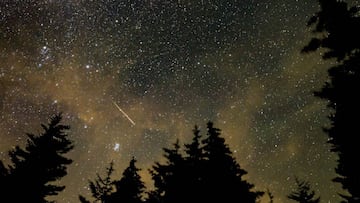The best time to watch the peak of the Geminids meteor shower today, Dec. 13: the brightest shooting stars of the year
Despite the bright Moon, the most reliable meteor shower of the year, the Geminids, will still put on a show worth staying up for. Here’s how to catch it.

Looking to make a wish on a shooting star? Well you’re in luck tonight. The Geminids meteor shower, one of the best and most reliable each year, will peak tonight December 13 into the early hours of the 14th.
Stargazers will have to contend with a bright waxing gibbous moon, one that is more than 50% illuminated on its way to being a full Moon, but they should still be able to see the brightest meteors. Normally you can see on average 50 or more shooting stars per hour, but perhaps that will be more like 15 due to the brightness of the Moon this year says NASA.
“This is still better than other annual showers,” notes the US space agency. “It is lucky that the Geminids are rich in bright meteors or the numbers this year would be even lower.”
The best time to watch the peak of the Geminids meteor shower today, Dec. 13
The action will get underway once the sky gets dark but the Geminids meteor shower will be best seen after 9 pm and before dawn, so grab a blanket if you are planning to sit outdoors to watch. The best rate will occur around 2 am, but NASA advises to “be mindful that meteors often come in spurts.”
You don’t need any special equipment as the shooting stars will be visible to the naked eye even though “the bright Moon will light up the sky and greatly reduce the number of visible meteors,” says Bill Cooke, lead for the Meteoroid Environment Office at NASA’s Marshall Space Flight Center in Huntsville, Alabama. He recommends “finding the darkest place you can,” and to “look away from the Moon.”
The brightest shooting stars of the year that could hit the ground!
Cooke also shared another fun fact about the Geminids that make them more unique than other meteor showers, that they “are one of only two meteor showers that can theoretically cause meteorites on the ground.” The other one being the Taurids.
Typically, most of the meteors in the Geminids shower burn up 30-40 miles up in the atmosphere. However, there is the ever-slightest chance that one of the space rocks may just be big enough to create a brilliant fireball that leaves small meteorites on the ground.
NASA points out though: “So far we haven’t found a Geminid meteorite, but there’s always hope.”
The Geminids are an annual meteor shower caused by the asteroid 3200 Phaethon
— Mambo Italiano (@mamboitaliano__) December 10, 2024
They are active from December 3 to 19, peaking between 13 and 14!
The meteors appear to originate from a radiant located a few degrees from Castor, the alpha star of Gemini 💫pic.twitter.com/8pFiNMatqC
What causes the Geminid meteor shower?
The Geminids meteor shower occurs every December and is active between December 7 and 17, but meteors associated with it can be seen earlier and later than this period. This is the time of the year “when Earth passes through a massive trail of dusty debris shed by a weird, rocky object named 3200 Phaethon,” explains NASA. That debris turns into shooting stars as it burns up in our atmosphere.
You may be asking, “Why is the source of the Geminids called ‘weird?’”
“Phaethon’s nature is debated. It’s either a near-Earth asteroid or an extinct comet, sometimes called a rock comet,” Cooke explains. 3200 Phaethon, which was only discovered in 1983, has also been called an “active asteroid.”
The Geminids are best seen in the northern hemisphere as the location of its radiant, usually a star or constellation close to where they appear in the night sky, which in this case is the constellation Gemini, doesn’t climb very high over the horizon in the southern hemisphere. However, the Geminids can appear anywhere in the night sky.
Related stories
Get your game on! Whether you’re into NFL touchdowns, NBA buzzer-beaters, world-class soccer goals, or MLB home runs, our app has it all.
Dive into live coverage, expert insights, breaking news, exclusive videos, and more – plus, stay updated on the latest in current affairs and entertainment. Download now for all-access coverage, right at your fingertips – anytime, anywhere.
